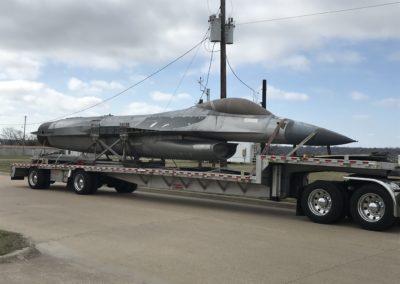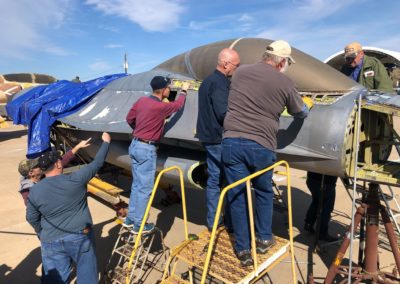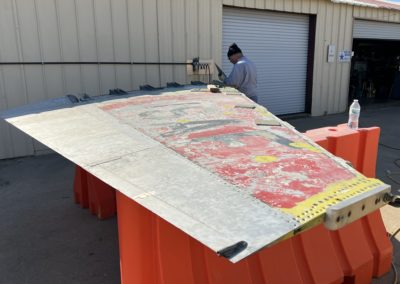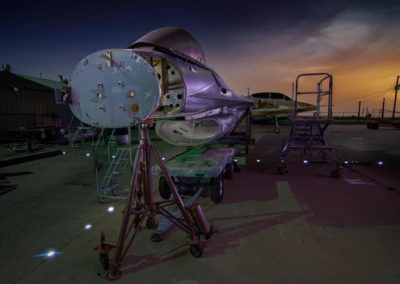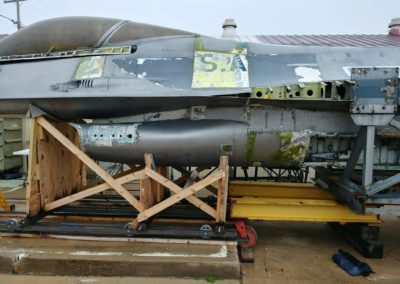YF-16 #2 Fighting Falcon
The General Dynamics YF-16 prototype represents a great leap forward in fighter aircraft technology and marked a new beginning – establishing a new standard for fighter performance and the economic rebirth of Fort Worth in the 1970s.
Warbird Overview
The General Dynamics YF-16 prototype represents a great leap forward in fighter aircraft technology and marked a new beginning – establishing a new standard for fighter performance and the economic rebirth of Fort Worth in the 1970s. The YF-16s were the first of over 4600 F-16s designed and built worldwide. 3,640 production F-16s were delivered from Fort Worth Air Force Plant No. 4 (the old “Bomber Plant“ on Lake Worth) and the rest were assembled at co-production facilities around the world using parts manufactured in Fort Worth.
ABOUT THE YF-16 #2
The General Dynamics YF-16 prototype represents a great leap forward in fighter aircraft technology and marked a new beginning – establishing a new standard for fighter performance and the economic rebirth of Fort Worth in the 1970s. The YF-16s were the first of over 4600 F-16s designed and built worldwide. 3,640 production F-16s were delivered from Fort Worth Air Force Plant No. 4 (the old “Bomber Plant“ on Lake Worth) and the rest were assembled at co-production facilities around the world using parts manufactured in Fort Worth.
General Dynamics YF-16 (tail number 72-01568) was the second of two prototypes built to compete in the Lightweight Fighter Program (LWF) in the early 1970s. It was designed and built in Fort Worth and airlifted to California for a flight test in the LWF fly-off versus the YF-17. After winning the LWF competition, the USAF and 29 other air forces around the world selected the production F-16 as their frontline multi-role fighter.
- 30° reclined pilot seat for increased “G” tolerance
- Single piece canopy with no bow frame for improved vision
- Relaxed static stability for reduced trim and maneuver drag
- Fly-by-wire flight control system with side stick
- Fixed normal shock inlet with forebody pre-compression
- Automatic variable camber wing for optimized cruise and maneuver
- Blended wing/body with forebody strakes for vortex lift and lower weight
In 2019, the aircraft was identified by museum staff as being declared surplus by the Air Force and requested for restoration and display. Following its last flight in 1979, YF-16 #2 served as an antenna test model for 40 years and had been heavily modified by Rome Labs. With the aid of U.S. Representative Kay Granger, the aircraft was assigned to the Fort Worth Aviation Museum by the USAF. The aircraft is on loan from the National Museum of the United States Air Force and is undergoing restoration.
Fact #1
This was the second YF-16 built to compete in the Lightweight Fighter Program.
Fact #2
That makes this the second of 4,500+ F-16s built.
Fact #3
After its flight demonstration duties were completed, the aircraft was sent to Rome, New York, to the Air Force Research Laboratory where it worked until it was acquired by us in 2020, making it the longest-serving F-16 ever.
Manufacturer: General Dynamics
Empty Weight: 13,191 pounds
Gross weight: 21,393 pounds (internal fuel)
Armament: M61A1 20mm Gatling gun (515 rounds) + 7 external hardpoints
Engine: One Pratt & Whitney F100-PW-100
Maximum Speed: Mach 2.0
Cruising Speed: 480 knots
Range: approx. 1800 miles (ferry range)
Service Ceiling: 50,000 ft
Span: 30 feet
Length: 48 feet, 6 inches
Height: 16 feet, 3 inches
Crew: One
This General Dynamics YF-16 is one of two prototypes built to compete in the US Air Force Light Weight Fighter (LWF) Competition. The F-16 won the competition against the YF-17 in January 1975.
The first YF-16 was revealed in a rollout ceremony at the Fort Worth factory on December 13, 1973. YF-16 #1 (72-01567) flew on 20 January 1974 with GD Test Pilot Phil Oestricher at the controls in what has come to be known as “Flight Zero”. On what started out to be high-speed taxi tests, the jet took to the air due to excessive idle thrust and higher than expected control sensitivity. Rather than fighting the aircraft, Oestricher let it do what it was supposed to do. He flew a large gentle pattern and landed safely. The engine idle setting and flight control gains were adjusted leading to a successful “First Flight” on 2 February 1974.
This second YF-16 (72-01568) first flew on 9 May 1974 with Neil Anderson at the controls. YF-16 #2 differed from the first example in having full capability to carry and drop weapons and external fuel tanks, as well as having a targeting radar and internal gun. The first aircraft was used for aerodynamic and handling qualities tests; the second aircraft performed tactical tests including weapons releases and air to air gunnery evaluation. YF-16 #2 had left the factory with a pale blue and white “Air Superiority” paint scheme. It was repainted gray for dogfighting evaluations and tactical tests, and then received the signature red, white, and blue air show paint scheme these aircraft are remembered for.
While being prepared for the Paris Air Show in 1975, YF-16 #2 was forced to land in the grass at Carswell AFB with the landing gear retracted. Test pilot Neil Anderson was at the controls and walked away from an amazing landing in this airplane. The aircraft was repaired and returned to test flying and demonstrations in 6 weeks.
Both YF-16 aircraft continued to work as chase and test aircraft for the Air Force as the program moved into the production of the F-16. YF-16 #2 was modified to carry and launch the AIM-7 Sparrow. As prototypes, they were designed to operate just a few hundred hours of flight time, but #2 flew over 900 hours. Following a routine flight in August 1979, the nose gear collapsed on landing, ending its flying days. It was shipped to Griffis AFB, New York, to begin its second career as a test airframe. The Air Force modified the aircraft to represent a production aircraft by stretching the fuselage 10 inches and grafting on a production nose and radar.
Air Force Research Lab in Rome, New York, also, known as Rome Labs, used the aircraft to test every Communication, Navigation, Identification, and Electronic Warfare antenna to be used on production F-16s. The tests included antenna evaluations with a full range of external stores, pods, and fuel tanks. The facility mounted the aircraft on tall towers to measure and tune the antenna patterns for the production aircraft. This historic YF-16 served in this role for 40 years until returning to Fort Worth for restoration and exhibit as a tribute to the many men and women who designed, built, and worked with the F-16 over the decades. FWAM is removing the modifications made by the Lab and will be returning YF-16 #2 to the configuration and paint job it wore in 1975 when it was declared the winner of the Light Weight Fighter competition.
This local significance is further brought home by the fact that the Fort Worth Aviation Museum has secured the loan of personal and program artifacts from the families of two of the General Dynamics YF-16 program test pilots, Phil Oestricher and Neil Anderson. These artifacts include flight reports, photos, manuals, flight gear, and models. These collections are aided by numerous personal donations of memorability related to the F-16 program provided by hundreds of current and retired GD and Lockheed Martin employees who worked on the program.
The first production aircraft rolled out of the factory in August 1978. Production continues today in Greenville, South Carolina. The aircraft is used by 30 countries with over 4,600 aircraft delivered and more on order. The F-16s have continued to be optimized for growth performance and expanded roles. Years later, test pilot Phil Oesticher saw YF-16 #1 and remarked “What a Wonderful Airplane.”
Good shape and will need a good wash and brush down.
Note: Scheduling is always a moving target depending on weather and workload. All schedules are subject to changes.
Become a Member!
FLIGHT SIMULATOR
HOURS
Saturday: 9AM-2PM
Sunday: 11AM-3PM
